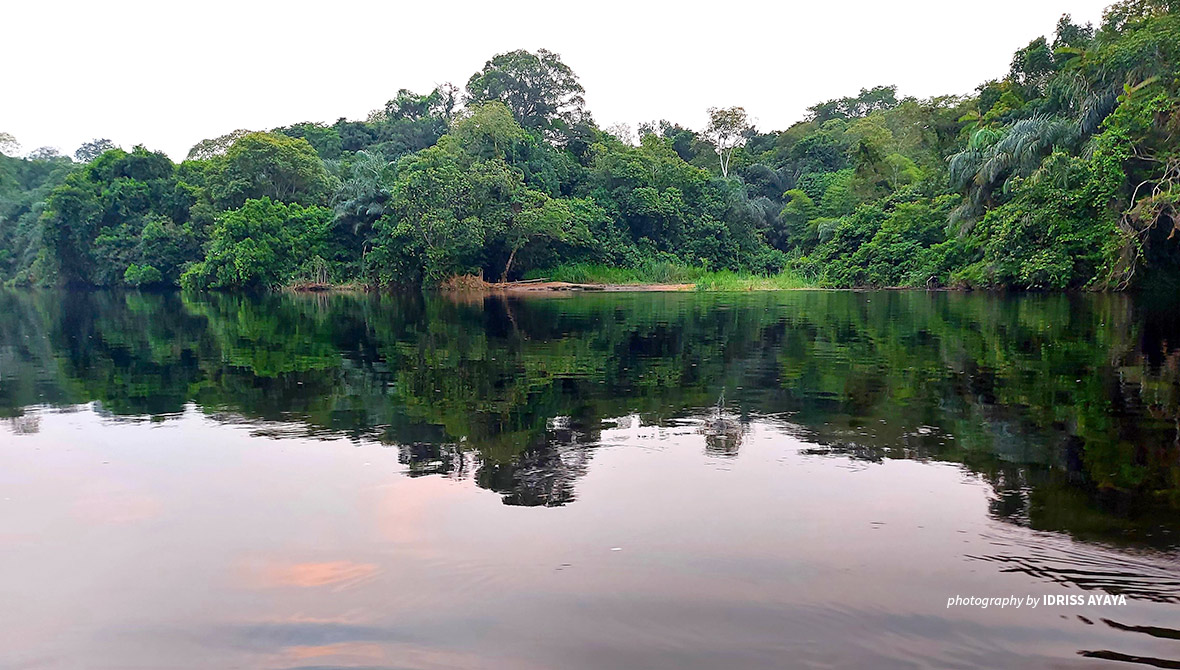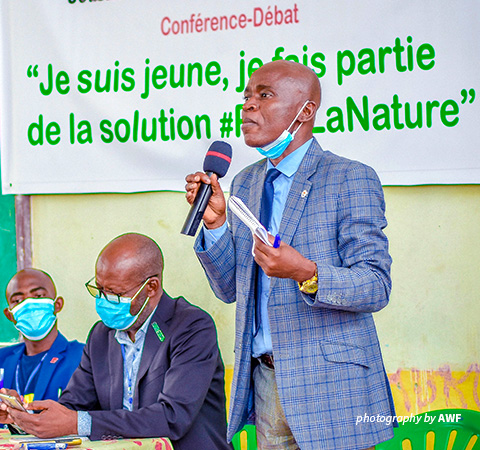DRC: AWF on the road to save the Congo Basin forests

AWF works with conservation organizations and forest communities in DRC's Maringa Lopori Wamba landscape
As a result of the global climate crisis, the Congo Basin is attracting the attention of the international community. States, international institutions, non-governmental organizations, and other private groups see the value of the Congo Basin rainforest, which covers nearly 301 million hectares out of 530 million hectares of land, comprising about 70 percent of Africa's forest cover, according to a 2013 Congo Basin Forest Partnership study.
Antoine Tabu, African Wildlife Foundation’s Country Coordinator in the Democratic Republic of Congo oversees conservation projects in the Maringa Lopori Wamba landscape in north-central DRC and the Bili-Uele Protected Area Complex further north. Having attended the UNFCCC COP27 negotiations in Sharm El Sheikh, Egypt, he explains how community-based projects to protect the Congo Basin in his country can mitigate global climate impacts and promote development.
What threatens the Congo Basin?
The basin is critical in regulating the climate because it sequesters more than 60 billion metric tons of carbon, more than all the tropical forests of Amazonia and Asia combined. However, a recent study revealed that the majestic forest of the Congo Basin is weakened by human activity: deforestation, exploitation of natural resources, and illegal trafficking of wildlife species.
Deforestation pressure varies from country to country. The leading cause of tree cover loss is agriculture around habitat areas and along roads. A 2010 Congo Basin Forest Partnership study found that selective logging in Central Africa has relatively little effect on forest cover, which changes little in the absence of agricultural pressure (as in Gabon). This situation is very different from Southeast Asia and Latin America, where deforestation leads to the conversion of forests into agro-industrial areas. In the Congo Basin, the annual deforestation rate has varied from 0 to 1 percent per year for the past 10 years, with an average of 0.4 percent, equivalent to 800,000 hectares of forest destroyed per year.
Currently, the most significant threats to biodiversity in DRC are anthropological. The unsustainable exploitation of wild biodiversity species through overfishing, deforestation caused by slash-and-burn agriculture, poaching, water and soil pollution (due to artisanal mining), and air pollution are the main activities driving landscape degradation. More recently, the introduction of invasive exotic species is becoming more prevalent. Climate change can certainly be added to the list of threats, all of which are aggravated by armed conflicts that lead to the occupation of protected areas by armed groups and refugees and the presence of transhumant herders.

Antoine Tabu, AWF’s Country Coordinator in the Democratic Republic of Congo
What are the benefits of conserving Africa’s forest resources?
The rainforests of Central Africa represent an important source of economic income, both in the formal sector (industrial timber exploitation) and in the informal sector (non-timber forest products, charcoal). Moreover, for a significant portion of the population, who are very poor, the forests are a lifeline; they would fall below the survival threshold without access to these resources. In a region that relies heavily on the extraction of fossil resources, some of which are now dwindling, the sustainable use of renewable forest resources is a major development issue.
Management plans for forest production concessions — an important instrument used for allocating public forests to a private entity — and the strengthening of protected area networks are emerging as strategies to reduce the pressures of forest degradation. Today, a common approach is to integrate conservation and production issues over larger territories by managing forest areas that include both protected areas and forest concessions.
It is now accepted that tropical forests represent much more than a directly marketable economic asset. However, the value of the environmental services provided by the forest — biodiversity, water and soil protection, climate stabilization and carbon storage, cultural and social values, and potential values for pharmacopeia — is still very poorly evaluated and is only just beginning to be included in the financial equations for long-term management of these ecosystems.
How can people living in forest landscapes benefit from conservation?
The good news is that local communities living in and around protected areas are no longer willing to remain passive in the face of this. Instead, communities recognize themselves as guardians of all the resources that abound in their forest, even though they are often excluded by protected area managers. For example, there are customary practices in the Maringa Lopori Wamba landscape that prohibit fishing and hunting during a certain period of the year.
Working side by side with local communities, AWF has created Local Conservation and Development Committees in the Maringa Lopori Wamba and Bili-Uele landscapes. These frameworks contribute to biodiversity conservation and community development by strengthening the collaboration between the protected area and local populations. Through socio-economic studies, we have identified the conditions leading people to exploit biodiversity and developed projects related to land-use planning to minimize habitat degradation and stop the progression of the savanna. In addition, promoting sustainable agriculture and providing access to markets has facilitated the creation of seven local forest concessions for community-based, sustainable forest management, particularly in the Maringa Lopori Wamba.
In the Bili-Mbomu landscape, AWF has obtained agreement from the local community to cede a portion of land covering 4,527.7 sq. kilometers rich in biodiversity inside the Central Zone of Bili-Mbomu to ensure safe passage for wildlife. Although talks are still underway at the national level to formalize this agreement, we can already count on the commitment of the Zande people.
How does this work mitigate climate change impacts?
To be part of the international fight against global warming and to promote the resources of the Congo Basin, AWF’s conservation efforts at the local level lend to the Nationally Determined Contribution. Additionally, we hope to engage youth at the provincial, territorial, and local levels in adopting more resilient techniques of natural resource use with less greenhouse gas emission while ensuring equitable sharing of the benefits of biodiversity conservation.
> Read AWF’s statement following the global climate conference in Egypt